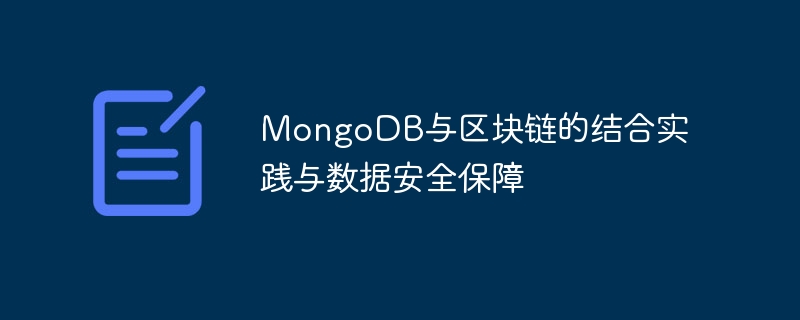
MongoDB is a popular open source document database, while blockchain is a distributed ledger technology. In recent years, with the advent of the digital age, more and more companies have begun to pay attention to the issues of data security and data protection. Against this background, more and more companies are beginning to explore and practice the combination of MongoDB and blockchain to achieve higher data security.
First, let us understand the characteristics of MongoDB. MongoDB is a non-relational database that stores data in the form of documents. The characteristics of this storage format make MongoDB very scalable and flexible, and can store various types of data, including structured, semi-structured and unstructured data. In addition, MongoDB also supports horizontal expansion and high availability, and can run in a distributed environment.
In contrast, blockchain technology is a technology based on decentralized and distributed architecture. Blockchain links transaction records in the form of blocks to form an immutable ledger. This decentralized feature makes the blockchain highly secure and tamper-proof. At the same time, blockchain can also realize automated business logic and data verification through smart contracts.
Combining MongoDB with blockchain can produce exciting results. First, by storing blockchain data in MongoDB, efficient query and processing of data can be achieved. Due to MongoDB's high scalability and flexibility, it can easily handle large amounts of blockchain data and provide high-performance data storage and access capabilities.
Secondly, through smart contracts, more complex business logic and data verification can be implemented in MongoDB. A smart contract is an automated computing code that can run on the blockchain. Through smart contracts, data verification and control can be achieved, and interactions with the MongoDB database can be achieved. This combination allows MongoDB to better manage and protect enterprise data.
At the same time, the integrity and security of the data in MongoDB can be guaranteed through the non-tampering and high security features of the blockchain. Enterprises can use blockchain to record and verify data changes in MongoDB, thereby ensuring the authenticity and legality of the data. This is extremely valuable for businesses with high requirements for data security and compliance.
However, the combination of MongoDB and blockchain also faces some challenges and difficulties. First of all, since blockchain is a distributed technology, when using MongoDB combined with blockchain, you need to deal with distributed consistency and concurrency control issues. This is a challenging problem for applications that require high concurrency and high performance.
In addition, due to the characteristics of the blockchain, its storage and query performance are relatively low. This makes it possible to encounter performance bottlenecks when using MongoDB combined with blockchain in high-load scenarios. Therefore, it is necessary to weigh the balance between performance and security and choose the appropriate solution based on actual needs.
In general, the combination of MongoDB and blockchain has potential and advantages in data security. It provides highly scalable, flexible and highly secure data storage and access capabilities. By combining the characteristics of smart contracts and blockchain, more complex business logic and data verification can be achieved. However, the combination of MongoDB and blockchain also faces challenges, and issues such as distributed consistency and performance bottlenecks need to be solved. Therefore, it is very important for businesses to choose a solution that suits their needs.
The above is the detailed content of MongoDB and blockchain integration practice and data security assurance. For more information, please follow other related articles on the PHP Chinese website!




